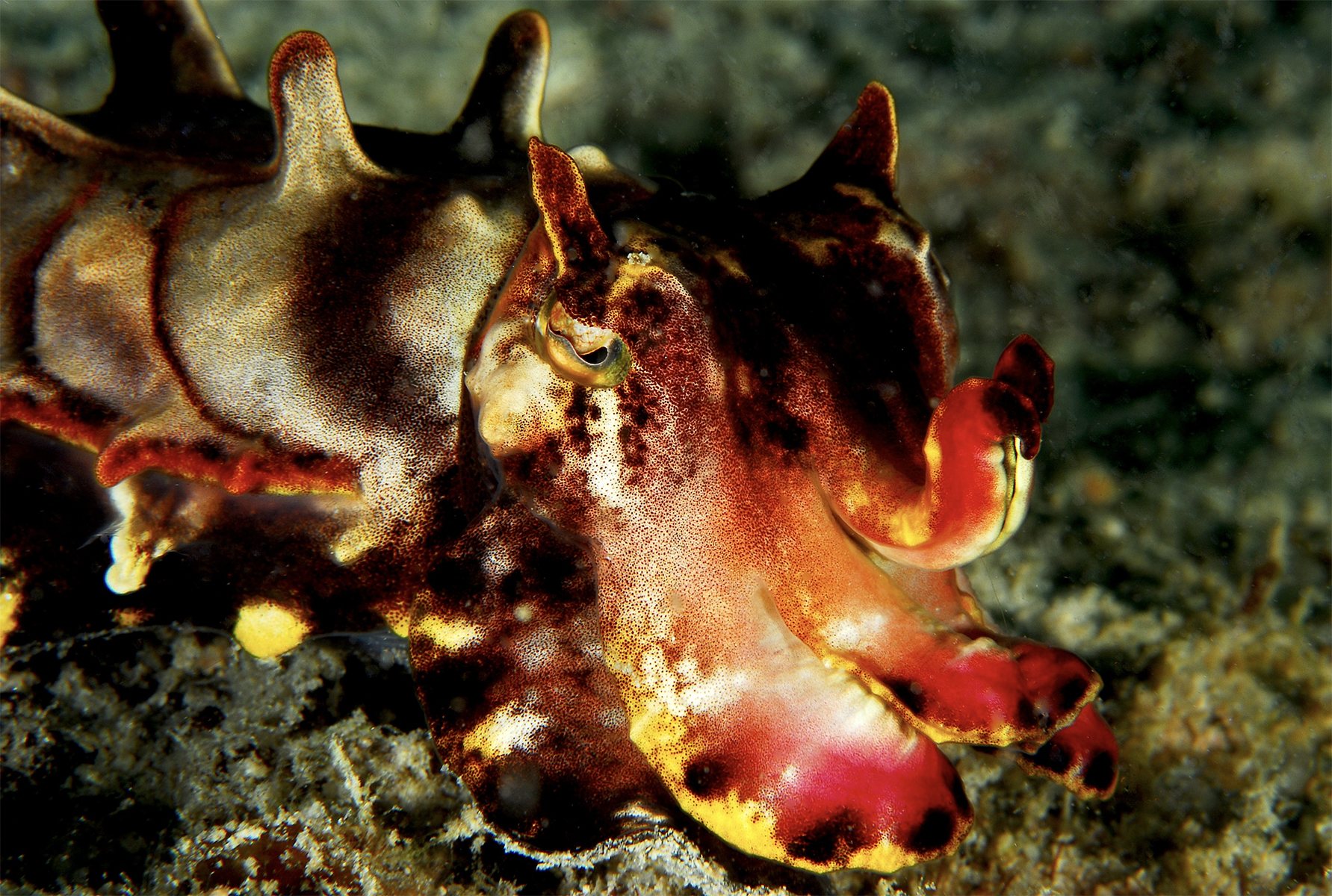Lobster eyes. Cuttlefish skin. Butterfly wings. Peacock feathers. Brittlestar armor. Clusterwink snail shells. These marvels of nature represent a vast intelligence that we’ve looked to for inspiration in engineering and design. Nature is teeming with algorithms waiting to be deciphered, categorized and applied. According to architect Michael Pawlyn, “There is extensive work under way to unlock the secrets of how biological organisms have evolved to manage light in various ways —gathering, distributing, focusing, diffusing, reflecting and
refracting.”¹
Today, we might turn to artificial intelligence (AI) for quick answers, inspiration and solutions that have value beyond the sum of their parts. AI, much like nature, excels at learning, adapting, optimizing processes and harnessing collective intelligence to solve complex problems. By acknowledging the parallels and intersections between AI and nature, we gain a deeper appreciation for how both serve as reservoirs of knowledge and innovation. The “where” we get information to solve a problem —be it from ChatGPT or a microscope lens on a butterfly wing— isn’t necessarily as important as the “why” and the “what’s next.”

Nature’s solutions to light manipulation, emission and control have taught us about iridescence, reflection, adaptive camouflage, color change, optical efficiency, photonics and bioluminescence. These principles form the basis for five key themes in nature-informed lighting technology that I have explored. While not exhaustive, these themes offer compelling insights and promise significant advancements in lighting.
• Color and structure: light manipulation. In nature, intricate nanostructures create vibrancy without pigment. These structures rely on the interference and diffraction of light to create colors that shift according to viewing angle—think butterfly wings and peacock feathers. This principle of structural coloration can inspire materiality explorations where the goal is to create the sense of dynamic color, without reliance on chemical dyes, and dynamic lighting control. For instance, I worked on a project where we used dichroic-glass light shelves that created a constantly dynamic color shift in a space relying solely on the Sun’s movement, achieving dynamic results even with the lights off. The budget was low, and dynamic lighting wasn’t in the realm of possibility.
• Adaptive and dynamic color change. Adaptive coloration in animals such as cuttlefish and chameleons showcases nature’s ability to dynamically control color and pattern throughspecialized cells. Cuttlefish skin changes color through chromatophores, which expand and contract to reveal different pigments, while iridophores and leucophores reflect light. Similarly, chameleon skin changes color via chromatophores and iridophores. These natural systems offer blueprints for developing materials capable of real-time, context-specific color change, such as dynamic camouflage for defense or responsive wayfinding systems in architecture. Imagine color-changing lighting that adapts to the clothing colors present in a room.
• Bioluminescence and bio-inspired lighting. Seen in organisms including fireflies and jellyfish, bioluminescence represents a highly efficient natural lighting system. It manages light generation, heat and communication effectively. An article in Nature Biotechnology, “Sustainable bioimaging using a fluorescent protein with unprecedented photostability,” highlights the idea of sourced intelligence: “The jellyfish-derived green fluorescent protein StayGold is bright and hardly fades, contributing to improving spatiotemporal resolution and dramatically extending the observation period. To fully benefit from the rich photon budget, we tried some unusual illumination modalities for sustainable, quantitative live-cell or volumetric imaging.”² The inspiration to develop sustainable, lowenergy lighting solutions is ongoing, and perhaps by harnessing these principles, engineers can leaves provide templates for developing advanced coatings and surfaces. These innovations can improve the efficiency of solar panels, reduce glare in optical devices, and enhance visibility in low-light conditions. In “The Irony of the Moth Eye” blog post, the author describes how the bumps on a moth’s eye work, and why it matters. It turns out that surfaces with these little bumps, which I will hereby just call motheyes, cause surfaces to transmit lots of light and reflect very little of it. That’s why moths have them in the first place: they can see better at night, and they won’t reflect glint back that predators could see. The Gordon group has developed a surface modification protocol, based on colloidal lithography and plasma etching, to create synthetic motheyes on inorganic substrates such as silicon. We can thus produce very useful, highly transmissive optics.³ NASA is also captivated by moth eyes. The post “Moth’s Eye Inspired Critical Component on SOFIA’s Newest Instrument” states that a moth’s eye “inspired the technology that allows a new NASA-developed camera to create images of astronomical objects with far greater sensitivity than was previously possible.”
• Light guiding and diffusion. The optical properties of materials like polar-bear fur, spider silk and glass-sponge spines highlight nature’s ability to guide and diffuse light effectively. Polar-bear fur’s hollow structure enhances insulation by trapping light and heat, while spider silk’s unique optical properties facilitate efficient light transmission. Glass-sponge spines, which transmit light with minimal loss, further exemplify natural light guiding. These designs can inspire advanced optical fibers and light-diffusing materials, improving the efficiency and effectiveness of lighting systems.
By categorizing these contributions into themes based on their technology or light manipulation methods, it becomes easier to see the diverse ways in which nature has inspired advancements in lighting. Continuing to investigate nature’s collective intelligence can lead to innovative solutions. As NASA scientist Ed Wollack suggested, “You can be inspired by something in nature, but you need to use the tools at hand to create it….This is what innovation is all about.” Just as we debate the definitions of “natural” and “artificial” light, we should consider “artificial” intelligence as part of the adaptive, problem solving capabilities inherent in both human ingenuity and natural evolution.
References
- Michael Pawlyn, Biomimicry in Architecture. London: RIBA Publishing, 2016.
- “Sustainable bioimaging using a fluorescent protein with unprecedented photostability,” Nature Biotechnology, vol. 40, no. 7, 2022.
- John Stair, “The Irony of the Moth Eye,” UCSB Undergraduate Research, Aug. 2015. Available: https://undergrad.research.ucsb.edu/2015/08/irony-moth-eye/
- Madison Olson, “Moth’s eye inspires critical component on SOFIA’s newest instrument,” NASA, Dec. 20, 2016. Available: www.nasa.gov/centers-and-facilities/ames/moths-eye-inspires-critical-component-onsofias-newest-instrument/
Brienne’s Bio-Inspired Library
If you are interested in learning more, please visit asknature.org and/or refer to the following selection of books:
Principles of Biomimicry:
• Biophilia by E.O. Wilson
• Biomimicry: Innovation Inspired by Nature by Janine M. Beynus
• Bioluminescence: Nature and Science at Work by MarZimmer
• Nature’s Patterns: A Tapestry in Three Parts by Philip Ball
Inspired Engineering:
• Biomimicry in Architecture by Michael Pawlyn
• The Gecko’s Foot: Bio-inspiration—Engineering New Materials from Nature by Peter Forbes
• Bulletproof Feathers: How Science Uses Nature’s Secrets to Design Cutting-Edge Technology by Robert Allen
• How to Walk on Water and Climb Up Walls: Animal Movement and the Robots of the Future by David L. Hu
Architectural and Computational Design
• Emergence: Morphogenetic Design Strategies, Editors Michael Hensel, Achim Menges and Michael Weinstock
• Techniques and Technologies in Morphogenetic Design, Editors Michael Hensel, Achim Menges and Michael Weinstock
• Versatility and Vicissitude: Performance in Morpho-Ecological Design, Editors Michael Hensel and Achim Menges
• Zoomorphic: New Animal Architecture by Hugh AlderseyWilliams
Brienne Willcock is director of Education and Standards for the IES.


